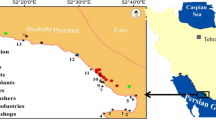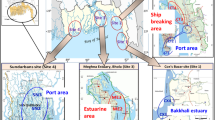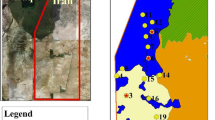Abstract
The US Environmental Protection Agency (US-EPA) published a priority list of 16 polycyclic aromatic hydrocarbons (PAHs), which are compounds that are studied in a variety of matrices due to their wide range of risks. Environmental compartments can be contaminated with PAHs from different sources, such as wastewater from industries and petroleum spills. For the case of Cameroon, there are no recorded data concerning the sources, distributions, and toxicity levels of PAHs in water and sediment from Cameroon beaches which are found in South-West, Littoral, and South Regions. In this work, only three beaches from South-West Region were studied regarding the sources, distributions, and toxicity levels of PAHs in water and sediment. The analyzed samples came from Bobende coastal beach, Down-beach, and Cape-Limboh beach. To achieve the analyses, liquid–liquid extraction and gas chromatography enabled the identification and quantification of PAH compounds from sediments and marine water. Out of the 16 PAHs listed by US-EPA, twelve were identified and quantified among which four of them were light molecular weight PAHs (acenaphthylene, fluorene, phenanthrene, and anthracene). Anthracene in the Cape-Limboh sample presented the highest concentration (477.57 ng/kg weight of dry sediment) of LMW-PAHs. Eight identified and quantified PAHs of high molecular weight as a whole, three absent PAHs (benzo[a]anthracene, dibenzo[a,h]anthracene, and benzo[g,h,i]perylene) in the Cape-Limboh sample, while only one is absent in the Bobende samples (dibenzo[a,h]anthracene) and Down Beach (benzo[g,h,i]perylene). According to the ratios used for the determination of the sources of PAHs, it came out that the source of PAHs from all beaches is pyrolytic. In all samples, BaA is the only high molecular weight PAH presenting serious toxicity and ecological risk.



Similar content being viewed by others
Data availability
Data can be provided on reasonable request.
References
Adedayo, A., Adeyemi, D., Uyimandu, J. P., Chigome, S., & Anyakora, C. (2012). Evaluation of the levels of polycyclic aromatic hydrocarbons in surface and bottom waters of Lagos Lagoon, Nigeria. African Journal of Pharmaceutical Sciences and Pharmacy, 3, 58–74.
Adeniji, A. O., Okoh, O. O., & Okoh, A. I. (2018). Analytical methods for polycyclic aromatic hydrocarbons and their global trend of distribution in water and sediment: A review. In: M. E.-S. AbdulRaouf (Ed.), Recent insights in petroleum science and engineering. ISBN: 978–953–51–5321–4. https://doi.org/10.5772/intechopen.71163
Al-Hassan, J., Afzal, M., Chava, V., & Fayad, S. (2001). Hydrocarbon pollution in the Arabian Gulf catfish (Arius bilineatus Val.). Bulletin of Environmental Contamination and Toxicology, 66, 646–652. https://doi.org/10.1007/s001280057
Al-Hassan, J., Afzal, M., Rao, C., & Fayad, S. (2000). Petroleum hydrocarbon pollution in sharks in the Arabian Gulf. Bulletin of Environmental Contamination and Toxicology, 65(3), 391–398. https://doi.org/10.1007/s0012800140
Bakker, M. I., Casado, B., Koerselman, J. W., Tolls, J., & Kollöffel, C. (2000). Polycyclic aromatic hydrocarbons in soil and plant samples from the vicinity of an oil refinery. The Science of the Total Environment, 263, 91–100. https://doi.org/10.1016/s0048-9697(00)00669-0
Baklanov, A., Hänninen, O., Slørdal, L. H., Kukkonen, J., Bjergene, N., Fay, B., et al. (2007). Integrated systems for forecasting urban meteorology, air pollution and population exposure. Atmospheric Chemistry and Physics, 7, 855–874. https://doi.org/10.5194/acp-7-855-2007
Cao, Z. G., Liu, J. L., Luan, Y., Li, Y. L., Ma, M. Y., Xu, J., & Han, S. L. (2010). Distribution and ecosystem risk assessment of polycyclic aromatic hydrocarbons in the Luan River, China. Ecotoxicology, 19(5), 827–837. https://doi.org/10.1007/s10646-010-0464-5
Chen, C.-F., Ju, Y.-R., Su, Y.-C., Lim, Y. C., Kao, C.-M., Chen, C.-W., & Dong, C.-D. (2020). Distribution, sources, and behavior of PAHs in estuarine water systems exemplified by Salt River, Taiwan. Marine Pollution Bulletin, 154, 111029. https://doi.org/10.1016/j.marpolbul.2020.111029
Ding, J., Zhong, J., Yang, Y., Li, B., Shen, G., Yuhong, Su., Wang, C., Li, W., Shen, H., Wang, B., Wang, R., Huang, Ye., Zhang, Y., Cao, H., Zhu, Y., Simonich, S. L. M., & Tao, S. (2011). Occurrence and exposure to polycyclic aromatic hydrocarbons and their derivatives in a rural Chinese home through biomass-fuelled cooking. Environmental Pollution, 169, 160–166. https://doi.org/10.1016/j.envpol.2011.10.008
Fourati, R., Tedetti, M., Guigue, C., Goutx, M., Zaghden, H., Sayadi, S., & Elleuch, B. (2017). Natural and anthropogenic particulate-bound aliphatic and polycyclic aromatic hydrocarbons in surface waters of the Gulf of Gabès (Tunisia, southern Mediterranean Sea). Environmental Science and Pollution Research, 25, 2476–2494. https://doi.org/10.1007/s11356-017-0641-7
Gabche, C. E., Folack, J., & Yongbi, G. C. (1998). Tarball levels on some beaches in Cameroon. Marine Pollution Bulletin, 36, 535–539. https://doi.org/10.1016/S0025-326X(97)00200-2
Giglioli, S., Colombo, L., Contestabile, P., Musco, L, Armiento, G., Somma, R., Vicinanza, D., & Azzellino, A. (2020). Source apportionment assessment of marine sediment contamination in a post-industrial area (Bagnoli, Naples). Water, 2181. https://doi.org/10.3390/w12082181
Helfrich, J., & Armstrong, D. E. (1986). Polycyclic aromatic hydrocarbons in sediments of southern basin of Lake Michigan. Journal of Great Lakes Research, 12, 192–199. https://doi.org/10.1016/S0380-1330(86)71718-8
Ifegwu, O. C., & Anyakora, C. (2016). Chapter six - Polycyclic aromatic hydrocarbons: Part II, urine markers. Advances in Clinical Chemistry, 75, 159–183. https://doi.org/10.1016/bs.acc.2016.03.001
Jessie, E. C. S., Ze Bilo’o, P., Kom Regonne, R., & Ngassoum, M. B. (2021). Source and distribution of polycyclic aromatic hydrocarbons (PAHs) in water from Mboppi River in Douala–Cameroon. Sustainability in Environment, 6(4). https://doi.org/10.22158/se.v6n4p1
Jones, K. C., Stratford, J. A., Waterhouse, K. S., Furlong, E. T., Giger, W., Hites, R. A., Schaffner, C., & Johnston, A. E. (1989). Increases in the polynuclear aromatic hydrocarbon content of an agricultural soil over the last century. Environmental Science & Technology, 23(1), 95–101. https://doi.org/10.1021/es00178a012
Kafilzadeh, F. (2015). Distribution and sources of polycyclic aromatic hydrocarbons in water and sediments of the Soltan Abad River, Iran. The Egyptian Journal of Aquatic Research, 41, 227–231. https://doi.org/10.1016/j.ejar.2015.06.004
Kalf, D. F., Crommentuijn, T., & Van de Plassche, E. J. (1997). Environmental quality objectives for 10 polycyclic aromatic hydrocarbons (PAHs). Ecotoxicology and Environmental Safety, 36, 89–97. https://doi.org/10.1006/eesa.1996.1495
Kannan, K., Kober, J. L., Khim, J. S., Szymczyk, K., Falandysz, J., & Giesy, J. P. (2003). Polychlorinated biphenyls, polycyclic aromatic hydrocarbons, and alkylphenols in sediments from the Odra River and its tributaries, Poland. Environmental Toxicology and Chemistry, 85, 51–60. https://doi.org/10.1080/0277221042000
Latimer, S., & Zheng, J. (2003). The sources, transport, and fate of PAHs in the marine environment. In: P. E. T. Douben (Ed.), PAHs: An ecotoxicological perspective. Wiley. https://doi.org/10.1002/0470867132.ch2
Malhat, F., Loutfy, N., El Menyawi, M. A. I., & Ahmed, M. T. (2021). Review of contamination by polycyclic aromatic hydrocarbons (PAHs) in Egyptian aquatic environment. Polycyclic Aromatic Compounds, 41(7), 1447–1458. https://doi.org/10.1080/10406638.2019.1684325
Ofori, A. S., Cobbina, S. J., & Doke, A. D. (2020). The occurrence and levels of polycyclic aromatic hydrocarbons (PAHs) in African environments—A systematic review. Environmental Science and Pollution Research. https://doi.org/10.1007/s11356-020-09428-2
Ofori, S. A., Cobbina, S. J., Imoro, A. Z., Doke, D. A., & Gaiser, T. (2021). Polycyclic aromatic hydrocarbon (PAH) pollution and its associated human health risks in the Niger Delta Region of Nigeria: A systematic review. Environmental Processes, 8, 455–482. https://doi.org/10.1007/s40710-021-00507-1
Olajire, A., Alade, A., Adeniyi, A., & Olabemiwo, O. (2007). Distribution of polycyclic aromatic hydrocarbons in surface soils and water from the vicinity of Agbabu bitumen field of Southwestern Nigeria. Journal of Environmental Science and Health, Part A: Toxic/hazardous Substances and Environmental Engineering, 42, 1043–1049. https://doi.org/10.1080/10934520701418474
Pampanin, D. M., Le Goff, J., Skogland, K., Marcucci, C. R., Øysæd, K. B., Lorentzen, M., Jørgensen, K. B., & Sydnes, M. O. (2016). Biological effects of polycyclic aromatic hydrocarbons (PAH) and their first metabolic products in in vivo exposed Atlantic cod (Gadus morhua). Journal of Toxicology and Environmental Health, Part A, 79(13–15), 633–646. https://doi.org/10.1080/15287394.2016.1171993
Rocher, V., Azimi, S., Moilleron, R., & Chebbo, G. (2004). Hydrocarbons and heavy metals in the different sewer deposits in the “Le Marais” catchment (Paris, France): Stocks, distributions, and origins. Science of the Total Environment, 323, 107–122. https://doi.org/10.1016/j.scitotenv.2003.10.010
Sun, C., Zhang, J., Ma, Q., Chen, Y., & Ju, H. (2016). Polycyclic aromatic hydrocarbons (PAHs) in water and sediment from a river basin: Sediment-water partitioning, source identification, and environmental health risk assessment. Environmental Geochemistry and Health. https://doi.org/10.1007/s10653-016-9807-3
Tening Ndifet, C. M., Ze Bilo’o, P., Kom Regone, R., & Ngassoum, M. B. (2021). Hydrocarbons pollution assessment on some aquatic organisms. Journal of Environmental Science, Computer Science and Engineering & Technology - Section A: Environmental Science, 10(1), 025–032. https://doi.org/10.24214/jecet.A.10.1.02532
Thayse Silva, A. L., Schwartz, M., Souza, P. M., Garrard, I., Campos-Takaki, G. M., & Tambourgi, E. B. (2017). Desulfurization of dibenzothiophene by Pseudomonas fluorescens (UCP 1514) leading to the production of biphenyl. In M. Zozeidavianpoor (Ed.), Recent insights in petroleum science and engineering. ISBN: 978–953–51–3810–5. https://doi.org/10.5772/intechopen.70430
Tongo, I., Ogbeide, O., & Ezemonye, L. (2017). Human health risk assessment of polycyclic aromatic hydrocarbons (PAHs) in smoked fish species from markets in Southern Nigeria. Toxicology Reports, 4, 55–61. https://doi.org/10.1016/j.toxrep.2016.12.006
Van de Wiele, T. R., Peru, K. M., Verstraete, W., Siciliano, S. D., & Headley, J. V. (2004). Liquid chromatography-mass spectrometry analysis of hydroxylated polycyclic aromatic hydrocarbons, formed in a simulator of the human gastrointestinal tract. Journal of Chromatography. b, Analytical Technologies in the Biomedical and Life Sciences, 806, 245–255. https://doi.org/10.1016/j.jchromb.2004.04.001
Wang, M., Wang, C., & Li, Y. (2017). Petroleum hydrocarbons in a water-sediment system from Yellow River estuary and adjacent coastal area, China: Distribution pattern, risk assessment, and sources. Marine Pollution Bulletin, 122, 139–148. https://doi.org/10.1016/j.marpolbul.2017.06.037
Yu, Y., Yu, Z., Wang, Z., Lin, B., LiChen, L. X., Zhu, X., Xiang, M., & Ma, R. (2018). Polycyclic aromatic hydrocarbons (PAHs) in multi-phases from the drinking water source area of the Pearl River Delta (PRD) in South China: Distribution, source apportionment, and risk assessment. Environmental Science and Pollution Research. https://doi.org/10.1007/s11356-018-1421-8
Yunker, M. B., Macdonald, R. W., Vingarzan, R., Mitchell, R. H., Goyette, D., & Sylvestre, S. (2002). PAHs in the Fraser River basin: A critical appraisal of PAH ratios as indicators of PAH source and composition. Organic Geochemistry, 33, 489–515. https://doi.org/10.1016/S0146-6380(02)00002-5
Ze Bilo’o, P., & Ngassoum, M. B. (2012). Characterization of polycyclic aromatic hydrocarbons (PAHs) in oily sludge from Cameroon petroleum refinery. International Journal of Environmental Sciences, 3, 509–517. https://doi.org/10.6088/ijes.2012030131050
Ze Bilo’o, P., Jessie, E. C. S., & Ngassoum, M. B. (2021). Study on source and distribution of polycyclic aromatic hydrocarbons (PAHs) in water and coastal sediment from the Ngoua River in Douala, Cameroon. Modern Advances in Geography, Environment and Earth Sciences, 6. https://doi.org/10.9734/bpi/magees/v6/4164F
Zeng, Q., Jeppesen, E., Gu, X., Mao, Z., & Chen, H. (2018). Distribution, fate, and risk assessment of PAHs in water and sediments from aquaculture- and shipping-impacted subtropical lake. China, Chemosphere. https://doi.org/10.1016/j.chemosphere.2018.03.031
Acknowledgements
The authors are grateful to the Limbe City Council for authorizing the realization of the assessment and to the Laboratory of Industrial Chemistry and Bioressources (LICB) of the National School of Agro-Industrial Sciences (ENSAI) of the University of Ngaoundere for the help of analytical measurement.
Author information
Authors and Affiliations
Corresponding author
Ethics declarations
Competing interest
The authors declare no competing interests.
Additional information
Publisher's note
Springer Nature remains neutral with regard to jurisdictional claims in published maps and institutional affiliations.
Rights and permissions
Springer Nature or its licensor (e.g. a society or other partner) holds exclusive rights to this article under a publishing agreement with the author(s) or other rightsholder(s); author self-archiving of the accepted manuscript version of this article is solely governed by the terms of such publishing agreement and applicable law.
About this article
Cite this article
Tening Ndifet, C.M., Ze Bilo’o, P., Mouthe Anombogo, G.A. et al. The study of three beaches of South-West Cameroon polluted by polycyclic aromatic hydrocarbons. Environ Monit Assess 195, 506 (2023). https://doi.org/10.1007/s10661-023-11111-1
Received:
Accepted:
Published:
DOI: https://doi.org/10.1007/s10661-023-11111-1




